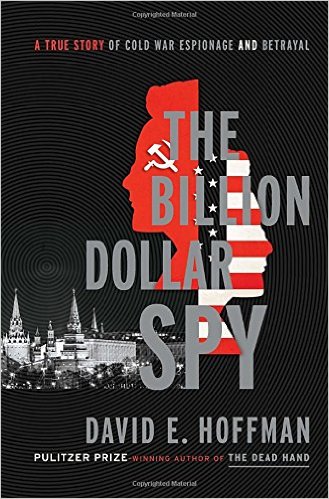A True Cold War Spy Thriller with Contemporary Relevance
The Billion Dollar Spy: A True Story of Cold War Espionage and Betrayal
David Hoffman
Doubleday (2015)
336 pages
I didn’t pick up The Billion Dollar Spy: A True Story of Cold War Espionage and Betrayal intending to review it. I read it—or, to be precise, listened to the audiobook—because I stumbled across a podcast of a book talk its author, journalist David Hoffman, had given and found myself intrigued by the story: that of one of the CIA’s most valuable agents in Moscow in the latter years of the Cold War.

Published by The Lawfare Institute
in Cooperation With

The Billion Dollar Spy: A True Story of Cold War Espionage and Betrayal
David Hoffman
Doubleday (2015)
336 pages
I didn’t pick up The Billion Dollar Spy: A True Story of Cold War Espionage and Betrayal intending to review it. I read it—or, to be precise, listened to the audiobook—because I stumbled across a podcast of a book talk its author, journalist David Hoffman, had given and found myself intrigued by the story: that of one of the CIA’s most valuable agents in Moscow in the latter years of the Cold War.
I was expecting to be engaged with a true-life John LeCarre-like story, and The Billion Dollar Spy certainly delivers on that.
But it also delivers a great deal more. It is a book about a largely unknown but hugely consequential and successful espionage operation. It is also one of the more careful journalistic portrayals of espionage tradecraft I have seen. Put simply, this is one of the best non-fiction portrayals of human intelligence collection I have ever read. (I do not, I should add, recommend the audiobook, which is badly marred by the reader's attempts to impersonate a Russian accent every time he speaks a line by a Russian.)
In this era in which we often trivialize the necessity of operational secrecy and lionize those who blow sensitive operations, it thus offers a certain caution about our current enthusiasms for openness and transparency in espionage. The Billion Dollar Spy—without ever mentioning the name Edward Snowden or Chelsea Manning or Wikileaks, indeed while focusing on a different era and on human intelligence, not technical collection—portrays the exquisite value, and the exquisite delicacy, of good intelligence and the secrecy necessary to collect it.
The Billion Dollar Spy tells the story of Adolf Tolkachev, a Russian radar engineer who volunteered to spy for the CIA Moscow station in the late 1970s and provided an immense trove of material on Soviet aviation and air defenses until his capture in 1985. In telling Tolkachev’s story, Hoffman has benefited both from a large volume of declassified operational papers and from extensive cooperation from former CIA officers who worked on the case. Hoffman’s dexterity with the bureaucratic history of the case itself, the CIA’s larger work against the Soviet target over time, and things Russia in general give the book a lot of informational heft behind its light, narrative, spy-thriller tone. Hoffman has written a true-spy book, but it’s a true-spy book with an unusual amount of hard information behind it. And in Hoffman’s hands, that information tells a remarkable story.
On the surface, that story is a Cold War yarn about Tolkachev and his remarkable run as a U.S. agent. It’s the story of how he approached the CIA in a gas station offering to spy, how the agency initially pushed him away and how he kept coming back, finally winning the hyper-cautious CIA over. It’s the story of how he first persuaded the agency to engage him at all and then bowled over the U.S. intelligence community and Air Force with the game-changing quality of the material he provided. It’s the story of his motivations and actions and the agency’s efforts to manage him, keep him safe, and often slow his production down to ensure his own protection. It’s the story of the technologies he used and those he didn’t use. It’s the story of the machinations inside the CIA—the push-and-pull between a Moscow station that had gold on its hands and a more risk-averse headquarters that wanted, at once, to go slow but also to pose endless questions to its star agent.
And it’s the story of Tolkachev’s incredible intelligence take over time, which the government assessed as worth literally billions of dollars, and which Hoffman—in a clever Epilogue set during the first Gulf War—assesses by a different means. In Vietnam, Hoffman reports, the United States lost one aircraft for every two it downed. By contrast, in Iraq and in the Balkans, U.S. planes down 48 and lost none:
By the end of the [first Iraq] war, U.S. Air Force planes had shot down thirty-nine airborne enemy aircraft, without losing one. Sixteen of the U.S. kills involved missile shots that were fired beyond visual range, at fighters the U.S. pilots could not even see, a remarkable new dimension in air combat, made possible because the U.S. fighters, guided by AWACS, could shoot with little risk of accidentally hitting friendly aircraft.
In direct aerial combat over Iraq, the U.S. Air Force downed every Soviet-built tactical fighter that it confronted. The reasons were many: superior technology, finely honed tactics, and vastly improved pilot training. But all of these advantages were bolstered by something less visible. The United States had collected every scrap of information it could find about Soviet planes, pilots, and radars, every photograph, diagram, and circuit board that could be obtained—by any means.
And for this, there was a spy.
All of this is fascinating and would be worth reading no matter what.
But Hoffman's book also tells another story, one more contemporary in its relevance. The Billion Dollar Spy is also, as I say, a story about tradecraft. Hoffman spends many pages describing the cat-and-mouse game of surveillance and surveillance detection conducted by the CIA and the KGB in Moscow. He spends even more pages describing the neurotic—but no doubt necessary—depths to which Tolkachev and his handlers went to escape detection. Along the way, Hoffman describes some of the other operations conducted out of Moscow at the same time. The book is, thus, among other things, a portrait of the intensity of effort associated with good intelligence collection.
It ultimately describes as well the fragility of those efforts. Because Tolkachev was not caught, as things turned out, because of any failure of his or any failure of the Moscow station.
The KGB caught up with him because of a leak: a disgruntled former CIA trainee who betrayed the information to the KGB.
For the record, no, I am not equating or condemning all leaks of classified operational information. And I’m not saying that we should understand the Snowden revelations as this sort of betrayal either.
I am saying, however, that Hoffman’s portrayal of the intense investment and extreme fragility of a major intelligence program offers a cautionary tale to those who celebrate the mass and indiscriminate disclosure of tens of thousands of pages of operational materials—materials over whose every word competent adversaries will then comb and whose scraps of information they will collate with other data collected elsewhere. Do the activists and journalists who trumpet these disclosures really understand what sort of losses they may involve—losses both of intelligence and, potentially, of people? Do they really understand how fragile the most valuable of intelligence operations, operations like Tolkachev’s, really are?
I doubt very much this question was on Hoffman’s mind as he wrote this book. But it was very much on my mind as I read it. And I recommend The Billion Dollar Spy, among its many other virtues, as a useful narrative text through which to ponder the question: What is intelligence really worth, and how precious are the secrets needed to do it well?




